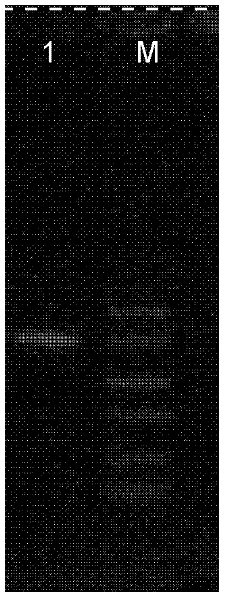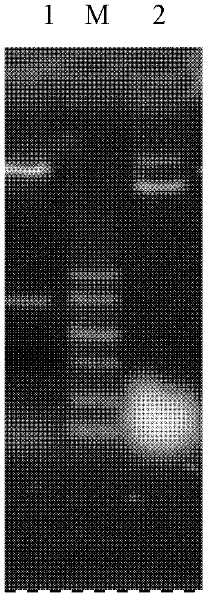Corn stress-inducible promoter and activity analysis
An inducible, promoter sequence technology, applied in the field of bioengineering, can solve problems such as plant growth retardation
- Summary
- Abstract
- Description
- Claims
- Application Information
AI Technical Summary
Problems solved by technology
Method used
Image
Examples
Embodiment 1
[0036] Example 1: Cloning of the drought-inducible promoter of the maize DRE binding protein gene (Zm DBF3)
[0037] The promoter of maize DRE binding protein gene (Zm DBF3) (promoter sequence comprises the DNA nucleotide sequence of -1bp to-1299bp region relative to the transcription initiation site of SEQ ID NO: 1), in maize DRE binding protein The sequence of the 5' untranslated region of the gene (ZmDBF3) was identified.
[0038] The maize DRE binding protein gene (Zm DBF3) is registered in NCBI GenBank (accession number: NM_001112181.1), and the sequence listing shows the DNA sequence of the plant drought-inducible promoter and 5' untranslated region of the above-mentioned gene of the present invention. exist figure 1 In , the start codon ATG for protein synthesis is underlined, and the base A of the transcription start site is shown with +1. And use the promoter analysis website to analyze the core elements of the promoter. The Promoter Analysis website is http: / / bioi...
Embodiment 2
[0042] Example 2: Construction of Plant Drought Inducible Vector
[0043] The promoter of the maize DRE-binding protein gene (Zm DBF3) cloned in Example 1 and the 148 bp 5' untranslated region Zm DBF3Pro (see sequence listing) were inserted into the vector to construct a plant drought-inducible vector.
[0044] More specifically, the plant expression vector pCAMBIA1301 and the recombinant plasmid pMD 18-T::Zm DBF3Pro were double-digested with EcoRI and NcoI, respectively, and then inserted into the EcoRI and NcoI restriction sites of the vector pCAMBIA1301. The vector is called pCAMBIA 1301::Zm DBF3Pro, which is used to drive the expression of the GUS gene, and is identified by enzyme digestion ( image 3 ) obtained the promoter fragment, which was the same as the expected result.
[0045] exist Figure 4 Among them, the gene GUS encoding β-glucuronidase was used as the reporter gene, and the selection marker was hygromycin resistance gene. In addition, 35s-pro represents t...
Embodiment 3
[0046] Example 3: Identification of the activity of a maize drought-inducible promoter
[0047] The vector pCAMBIA 1301::Zm DBF3Pro constructed in Example 2 was transferred to Agrobacterium tumefaciens EHA105 by the heat shock transformation method, and the plasmid was extracted and identified by enzyme digestion.
[0048] In order to identify the drought-inducible activity of the promoter, the method of Jefferson et al. (EMBO J, 1987) was used to test the activity of GUS after drought treatment of the embryos of maize after Agrobacterium infection.
[0049] More specifically, soak the corn seeds to accelerate germination, then cut the seeds longitudinally, cut them in half, induce culture with 20% PEG for 24 hours, put the corn seeds in the GUS detection solution at 37°C overnight, GUS detection solution: 3mg / ml X-gluc (5-bromo-4-chloro-3-indole-β-D-glucuronide), 50mM sodium phosphate buffer solution (PH=7.0), 10mM EDTA, 0.5mM potassium ferricyanide, 0.5mM Potassium ferricya...
PUM
 Login to View More
Login to View More Abstract
Description
Claims
Application Information
 Login to View More
Login to View More - R&D
- Intellectual Property
- Life Sciences
- Materials
- Tech Scout
- Unparalleled Data Quality
- Higher Quality Content
- 60% Fewer Hallucinations
Browse by: Latest US Patents, China's latest patents, Technical Efficacy Thesaurus, Application Domain, Technology Topic, Popular Technical Reports.
© 2025 PatSnap. All rights reserved.Legal|Privacy policy|Modern Slavery Act Transparency Statement|Sitemap|About US| Contact US: help@patsnap.com



